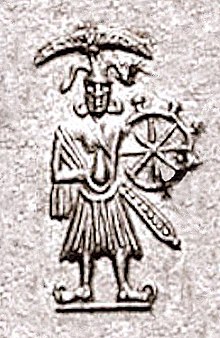বাসুদেব

কৃষ্ণ বাসুদেব পূজা হল ঐতিহাসিক ভাবে কৃষ্ণধর্ম ও বৈষ্ণবধর্মের অন্যতম আদি রূপ। বাসুদেব কৃষ্ণ কথাটির অর্থ হল বসুদেবের পুত্র কৃষ্ণ। এটি ছিল প্রাচীনকালের কৃষ্ণপূজার একটি অন্যতম প্রধান ধারা। এই ধারাটি ছিল সম্পূর্ণ পৃথক একটি ধারা। পরে এটি অন্য ধারার সঙ্গে মিশে যায়। ভাগবতধর্ম, গোপাল কাল্ট ও বালগোপাল কাল্টের সঙ্গে এই ধারাটি মিশে গিয়ে বর্তমান বৈষ্ণবধর্মের একেশ্বরবাদী রূপটি গড়ে উঠেছে।[১][২] কোনো কোনো প্রাচীন পণ্ডিত এই ধারাটিকে ভাগবতধর্মের সঙ্গে এক করে দেখেন।[৩] এই ধর্মীয় প্রথাটির প্রতিষ্ঠাতা মনে করা হয় স্বয়ং কৃষ্ণকে। তিনি ছিলে বসুদেবের পুত্র। তাই তাঁর অপর নাম ছিল বাসুদেব। তিনি ঐতিহাসিক সত্বত জাতির বাসভূমিতে বসা করতেন। তাদের মতে, কৃষ্ণের অনুগামীদের বলা হত ভাগবত। এই ধর্ম প্রতিষ্ঠিত হয় খ্রিস্টপূর্ব দ্বিতীয় শতকে (পতঞ্জলির সমসাময়িক) অথবা খ্রিস্টপূর্ব চতুর্থ শতকে (মেগাস্থিনিস ও কৌটিল্যের অর্থশাস্ত্রের বর্ণনা থেকে জানা যায়)। এই ধর্মে বাসুদেব হলেন সর্বোচ্চ ঈশ্বর।[৪] এই ধর্মের বাইরে ভক্তকে অনেক স্থানে "বাসুদেবক" বলে উল্লেখ করা হয়েছে।[৫]
হরিবংশে কৃষ্ণ, বসুদেব, সঙ্কর্ষণ, প্রদ্যুম্ন ও অনিরুদ্ধের মধ্যে জটিল সম্পর্কগুলির ব্যাখ্যা আছে। এগুলিই পরে বৈষ্ণব অবতার ধারণার জন্ম দেয়।
আরও দেখুন
[সম্পাদনা]পাদটীকা
[সম্পাদনা]- ↑ KLOSTERMAIER, Klaus K. (২০০৫)। A Survey of Hinduism। State University of New York Press; 3 edition। পৃষ্ঠা 206। আইএসবিএন 0-7914-7081-4।
Present day Krishna worship is an amalgam of various elements. According to historical testimonies Krishna-Vasudeva worship already flourished in and around Mathura several centuries before Christ. A second important element is the cult of Krishna Govinda. Still later is the worship of Bala-Krishna, the Divine Child Krishna - a quite prominent feature of modern Krishnaism. The last element seems to have been Krishna Gopijanavallabha, Krishna the lover of the Gopis, among whom Radha occupies a special position. In some books Krishna is presented as the founder and first teacher of the Bhagavata religion.
- ↑ BASHAM, A. L.। "Review:Krishna: Myths, Rites, and Attitudes. by Milton Singer; Daniel H. H. Ingalls, The Journal of Asian Studies, Vol. 27, No. 3 (May, 1968 ), pp. 667-670"। www.jstor.org। জেস্টোর 2051211।
- ↑ Hastings 2003, পৃ. 540
- ↑ Hastings 2003, পৃ. 540–42
- ↑ SINGH, R.R. (২০০৭)। Bhakti And Philosophy। Lexington Books। আইএসবিএন 0-7391-1424-7।
- p. 10: "[Panini's] term Vāsudevaka, explained by the second century B.C commentator Patanjali, as referring to "the follower of Vasudeva, God of gods."
তথ্যসূত্র
[সম্পাদনা]- Hastings, James Rodney (2nd edition 1925-1940, reprint 1955, 2003) [1908-26]। [[Encyclopedia of Religion and Ethics]]। John A Selbie (Volume 4 of 24 ( Behistun (continued) to Bunyan.) সংস্করণ)। Edinburgh: Kessinger Publishing, LLC। পৃষ্ঠা 476। আইএসবিএন 0-7661-3673-6। সংগ্রহের তারিখ 2008-05-03।
The encyclopedia will contain articles on all the religions of the world and on all the great systems of ethics. It will aim at containing articles on every religious belief or custom, and on every ethical movement, every philosophical idea, every moral practice.
এখানে তারিখের মান পরীক্ষা করুন:|তারিখ=(সাহায্য); ইউআরএল–উইকিসংযোগ দ্বন্দ্ব (সাহায্য) - Hein, Norvin। "A Revolution in Kṛṣṇaism: The Cult of Gopāla: History of Religions, Vol. 25, No. 4 (May, 1986 ), pp. 296-317"। www.jstor.org। জেস্টোর 1062622।
- SINGER, Milton (১৯০০)। Krishna Myths Rites & Attitudes। UNIVERSITY OF CHICAGO। আইএসবিএন 0-313-22822-1। এএসআইএন B000PVXLYQ।
- Delmonico, N. (২০০৪)। "The History Of Indic Monotheism And Modern Chaitanya Vaishnavism"। The Hare Krishna Movement: the Postcharismatic Fate of a Religious Transplant। Columbia University Press। আইএসবিএন 978-0-231-12256-6। সংগ্রহের তারিখ ২০০৮-০৪-১২।
- Mahony, W.K. (১৯৮৭)। "Perspectives on Krsna's Various Personalities"। History of Religions। 26 (3): 333–335। জেস্টোর 198702। ডিওআই:10.1086/463085।
- BHATTACHARYA, Gouriswar: Vanamala of Vasudeva-Krsna-Visnu and Sankarsana-Balarama. In: Vanamala. Festschrift A.J. Gail. Serta Adalberto Joanni Gail LXV. diem natalem celebranti ab amicis collegis discipulis dedicata. Gerd J.R. Mevissen et Klaus Bruhn redigerunt. Berlin 2006; pp. 9–20.
- COUTURE, André: The emergence of a group of four characters (Vasudeva, Samkarsana, Pradyumna, and Aniruddha) in the Harivamsa: points for consideration. Journal of Indian Philosophy 34,6 (2006) 571-585.
Text is available under the CC BY-SA 4.0 license; additional terms may apply.
Images, videos and audio are available under their respective licenses.
